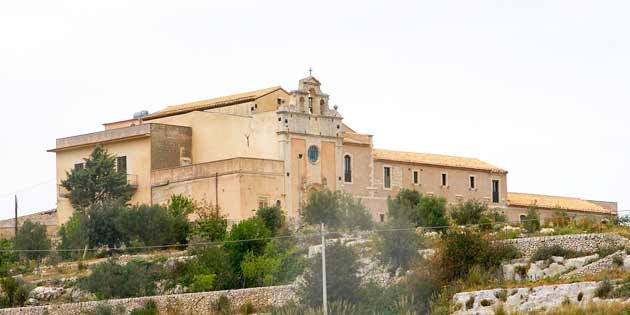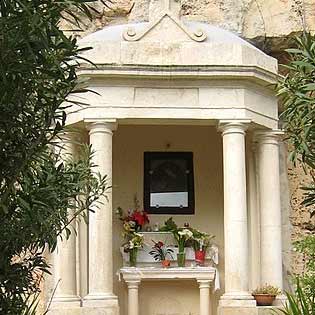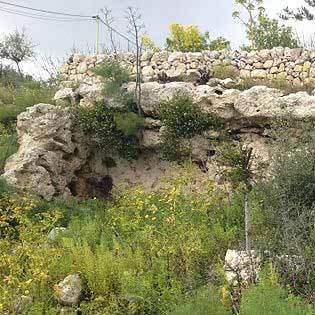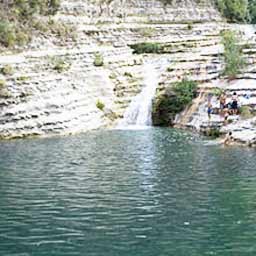Hermitage of Avola Antica
The Hermitage of Avola Antica , also known as Convent Sanctuary Madonna delle Grazie , was once guarded by a group of Capuchin monks, overlooks the precipice of Bugliola, offering the viewer an enchanting panoramic view of the Ionian coast.
The complex was built in 1729, over the remains of the Capuchin convent, at the behest of the priest Sebastiano Li Gioi, who wanted to revitalize and restore sacredness to the ruins of Ancient Avola. The dormitory later took the name of Eremo della Madonna delle Grazie due to the legendary discovery, in the 1860s, under a large boulder, of a bell and a limestone bas-relief depicting the Madonna delle Grazie, now kept in the church of 'Hermitage. In 1896 in memory of this event, a votive shrine was built. Recently the complex of the Madonna delle Grazie has undergone a careful conservative restoration.
The complex consists of the Church of the Madonna delle Grazie and the annexed monastery .
The church has a single-body façade having, in the lower part, the access portal and, on the top, the belfry with three arches of which the central, higher one, is surmounted by a tympanum. Inside the arches there are bells while two spiral volutes conclude their external profiles by connecting with the underlying entablature. The portal has, on the sides, two protruding pilasters with Tuscan capitals, supporting piers decorated with acanthus leaves. These, in turn, support elegant vases filled with fruit and leaves. The round arch of the portal has the key marked by a head while a broken arch, placed above it, acts as a closure to the whole and at the same time acts as a connecting element with the parts of the façade walls defined in limestone . A rose window in the center has the task of illuminating the choir.
The interior of the church, with one nave, has an elegant liberty railing that separates the nave from the presbytery. The latter is covered with early twentieth-century tiles with rhomboidal motifs with stylized leaves in brick red, beige and black, while the nave retains square paving stones. The main altar, in 1925 underwent heavy renovations, but in 1984 following a fortuitous case, some thieves had torn it up, part of the original eighteenth-century altar emerged: concave in the central part and with Rococo decorations. On the side it has two protruding volutes decorated at the base by large acanthus leaves bearing, in the upper part, splendid heads of Serpottian cherubs.
The canvas-altarpiece of the main altar of the church was of considerable value, following a theft this canvas has disappeared. Today it is possible to admire only one copy, of the same size as the original, donated by a faithful couple. The canvas, the work of Olivio Sozzi and his best pupil, can be dated to around the early 1700s. The pictorial layout follows the setting of other Sozzi paintings, in fact, at the top, opening the canvas scenario, the Santissima stands out gloriously. Trinity in a myriad of angels, depicted by Christ holding the Cross, in the center the Dove of the Holy Spirit on the right the Eternal Father with open arms. In the center is the full figure of the Madonna delle Grazie crowned with the twelve stars, which entirely holds the Holy Child Jesus, as if she wanted to offer it to the patron saints of Avola. Santa Venera, patron saint of Avola, on the left and Corrado, the protector of the city, on the right, closing the canvas at the bottom. Alongside you can see the symbolic signs linked to the actions of faith in their life: Santa Venera holds in her right hand the palm of martyrdom with three crowns, while an angel at her feet holds a Crucifix, as the primary instrument of her preaching; The angel at the feet of San Corrado holds the eremitic staff and beside him the skull and the rosary crown, instruments of penance and prayer of the saint who lived his eremitical life between Avola and Noto in the sixteenth century.
The church also preserves the effigy of a painted stone bas-relief which was found by chance at the end of the 1700s in the place of ancient Avola where the previous church of the Capuchin convent was to be located. The handcrafted image depicts, in a traditional setting, the Madonna nursing the Child. There is also the small bronze bell, finely decorated, found together with the bas-relief.
To the right of the church is the entrance to the convent . This rests its foundations on the limestone cliff that acts as a wall to the underlying quarry and is built with irregular stone blocks bound by cement mortar. The lines of the convent follow the course of the ground. The windows highlight the extreme simplicity of the external walls of the hermitage. Culminating with a lowered arch, they present, in the keys, hieratic female figures almost wrapped in acanthus foliage, while delicately carved shelves support the architraves above decorated, in the lower part, with protruding denticles. Large, with large ambulatories, is the interior where the numerous cells and other rooms open.
The Hermitage on the anniversary of the Madonna delle Grazie on 2 July and of the Madonna Assunta on 15 August is frequented by the faithful of the city of Avola for celebrations and Eucharistic celebrations.



